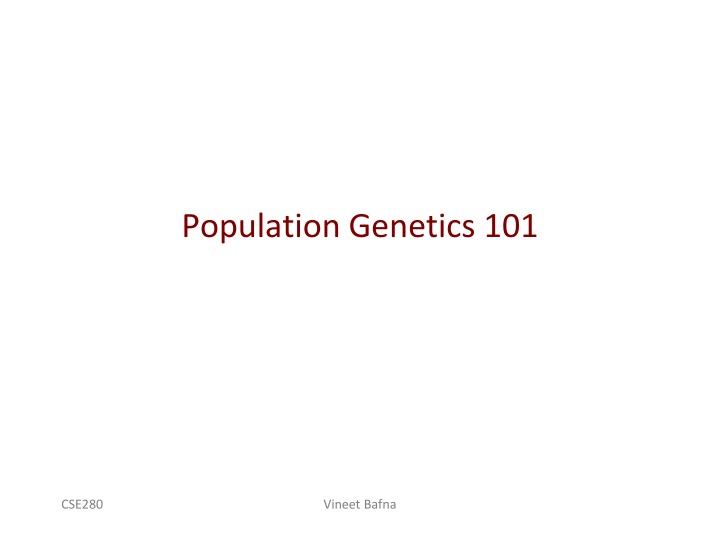
Genetic Variation and Population Genetics in Biology
Explore the genetic basis of phenotypic differences within populations, the consequences of DNA mutations, and the impact of natural selection on genetic diversity. Learn about comparative genomics, random drift, and the power of personalized genomics in understanding individual and population genetics.
Download Presentation

Please find below an Image/Link to download the presentation.
The content on the website is provided AS IS for your information and personal use only. It may not be sold, licensed, or shared on other websites without obtaining consent from the author. If you encounter any issues during the download, it is possible that the publisher has removed the file from their server.
You are allowed to download the files provided on this website for personal or commercial use, subject to the condition that they are used lawfully. All files are the property of their respective owners.
The content on the website is provided AS IS for your information and personal use only. It may not be sold, licensed, or shared on other websites without obtaining consent from the author.
E N D
Presentation Transcript
Population Genetics 101 CSE280 Vineet Bafna
Personalized genomics April 08 Bafna
From an individual to a population It took a long time (10-15 yrs) to produce the draft sequence of the human genome. Soon (within 10-15 years), entire populations can have their DNA sequenced. Why do we care? Individual genomes vary by about 1 in 1000bp. These small variations account for significant phenotype differences. Disease susceptibility. Response to drugs How can we understand genetic variation in a population, and its consequences? CSE280 Vineet Bafna
Population Genetics Individuals in a species (population) are phenotypically different. Often these differences are inherited (genetic). Understanding the genetic basis of these differences is a key challenge of biology! The analysis of these differences involves many interesting algorithmic questions. We will use these questions to illustrate algorithmic principles, and use algorithms to interpret genetic data. CSE280 Vineet Bafna
Variation in DNA The DNA is inherited by the child from its parent. The copying is not identical, but might be mutated. If the mutation lies in a gene, . Different proteins are produced Different proteins are switched on or off Different phenotype. CSE280 Vineet Bafna
Random Drift and Natural selection Darwin suggested the following: Organisms compete for finite resources. Organisms with favorable mutations are more likely to reproduce, leading to fixation of favorable mutations (Natural selection). Over time, the accumulation of many changes suitable to an environment leads to speciation. Kimura (1960s) observed Most mutations are selectively neutral! They drift in the population, eventually getting eliminated, or fixed by random chance. CSE280 Vineet Bafna
(Comparative) Genomics vs. (Population) Genetics Mutations accumulate over time In looking at the DNA of different species DNA has had a lot of time to mutate, and is not expected to be identical. If the DNA is highly similar, that region is functionally important. In comparing DNA from a population Not enough time to mutate, so DNA is expected to be identical. The few differences that exist mediate phenotypic differences. CSE280 Vineet Bafna
Population genetics By sampling DNA from a population, we can answer the following What are the sources of variation? As mutations arise, they are either neutral and subject to evolutionary drift, or they are (dis-)advantageous and under selective pressure. Can we tell? If you had DNA from many sub-populations, Asian, European, African, can you separate them? Why are some people more likely to get a disease then others? How is disease gene mapping done? Phasing of chromosomes. How do we separate the maternal and paternal chromosomes CSE280 Vineet Bafna
Terminology: allele Allele: A specific variant at a location The notion of alleles predates the concept of gene, and DNA. Initially, alleles referred to variants that described a measurable trait (round/wrinkled seed) Now, an allele might be a nucleotide on a chromosome, with no measurable phenotype. As we discuss source of variation, we will have different kinds of alleles. CSE280 Vineet Bafna
Terminology Locus: The location of the allele A nucleotide position. A genetic marker A gene A chromosomal segment CSE280 Vineet Bafna
Terminology Genotype: genetic makeup of (part of) an individual Phenotype: A measurable trait in an organism, often the consequence of a genetic variation Humans are diploid, they have 2 copies of each chromosome, and 2 alleles at each locus They may have heterozygosity/homozygosity at a location Other organisms (plants) have higher forms of ploidy. Additionally, some sites might have 2 allelic forms, or even many allelic forms. Haplotype: genetic makeup of (part of) a single chromosome CSE280 Vineet Bafna
What causes variation in a population? Mutations (may lead to SNPs) Recombinations Other crossover events (gene conversion) Structural Polymorphisms CSE280 Vineet Bafna
Single Nucleotide Polymorphisms Small mutations that are sustained in a population are called SNPs SNPs are the most common source of variation studied The data is a matrix (rows are individuals, columns are loci). Only the variant positions are kept. A->G CSE280 Vineet Bafna
Single Nucleotide Polymorphisms Infinite Sites Assumption: Each site mutates at most once 00000101011 10001101001 01000101010 01000000011 00011110000 00101100110 CSE280 Vineet Bafna
Short Tandem Repeats GCTAGATCATCATCATCATTGCTAG GCTAGATCATCATCATTGCTAGTTA GCTAGATCATCATCATCATCATTGC GCTAGATCATCATCATTGCTAGTTA GCTAGATCATCATCATTGCTAGTTA GCTAGATCATCATCATCATCATTGC 4 3 5 3 3 5 CSE280 Vineet Bafna
STR can be used as a DNA fingerprint Consider a collection of regions with variable length repeats. Variable length repeats will lead to variable length DNA The locations are far enough apart not to be linked Vector of lengths is a finger- print 4 2 3 3 5 1 3 2 3 1 5 3 loci CSE280 Vineet Bafna
Structural polymorphisms Large scale structural changes (deletions/insertions/inversions) may occur in a population. Copy Number variation Certain diseases (cancers) are marked by an abundance of these events CSE280 Vineet Bafna
Personalized genome sequencing These variants (of which 1,288,319 were novel) included 3,213,401 single nucleotide polymorphisms (SNPs), 53,823 block substitutions (2 206 bp), 292,102 heterozygous insertion/deletion events (indels)(1 571 bp), 559,473 homozygous indels (1 82,711 bp), 90 inversions, as well as numerous segmental duplications and copy number variation regions. Non-SNP DNA variation accounts for 22% of all events identified in the donor, however they involve 74% of all variant bases. This suggests an important role for non-SNP genetic alterations in defining the diploid genome structure. Moreover, 44% of genes were heterozygous for one or more variants. PLoS Biology, 2007 CSE280 Vineet Bafna
Recombination 00000000 11111111 00011111 Not all DNA recombines! CSE280 Vineet Bafna
Human DNA Not all DNA recombines. mtDNA is inherited from the mother, and y-chromosome from the father CSE280 Vineet Bafna http://upload.wikimedia.org/wikipedia/commons/b/b2/Karyotype.png
Gene Conversion Gene Conversion versus single crossover Hard to distinguish in a population CSE280 Vineet Bafna
Quiz Allele Locus Recombination Mutation/Single nucleotide polymorphism STR (short tandem repeat) How is DNA fingerprinting done Infinite sites assumption CSE280 Vineet Bafna
A QUICKTOUR. HOWTOIDENTIFYTHE GENETICBASISOFA PHENOTYPE CSE280 Vineet Bafna
Looking for the mutation in populations A possible strategy is to collect cases (affected) and control individuals, and look for a mutation that consistently separates the two classes. Next, identify the gene.
Looking for the causal mutation in populations Problem 1: many unrelated common mutations, around one every 1000bp Case Control
Case Control
Looking for the causal mutation in populations Problem 2: We may not sample the causal mutation. Case Control
How to hunt for disease genes Case Control We are guided by two simple facts governing these mutations 1. Nearby mutations are correlated 2. Distal mutations are not
The basics of association mapping 0 0 0 0 1 1 Case Control 1 1 Sample a population of individuals at variant locations across the genome. Typically, these variants are single nucleotide polymorphisms (SNPs). Create a new bi-allelic variant corresponding to cases and controls, and test for correlations. By our assumptions, only the proximal variants will be correlated. Investigate genes near the correlated variants.
So, why should the proximal SNPs be correlated, and distal SNPs not?
A bit of evolution Time Consider a fixed population (of chromosomes) evolving in time. Each individual arises from a unique, randomly chosen parent from the previous generation
Time Current (extant) population (a) Genealogy of a chromosomal population
Adding mutations Infinite sites assumption: A mutation occurs at most once at a site.
SNPs The collection of acquired mutations in the extant population describe the SNPs
Disease mutation We drop the ancestral chromosomes, and place the mutations on the internal branches.
Disease mutation A causal mutation creates a clade of affected descendants.
Disease mutation Note that the tree (genealogy) is hidden. However, the underlying tree topology introduces a correlation between each pair of SNPs
a. b. c.
Recombination In our idealized model, we assume that each individual chromosome chooses two parental chromosomes from the previous generation
A bit of evolution Proximal SNPs are correlated, distal SNPs are not. The correlation (Linkage disequilibirium) decays rapidly after 20-50kb
Association mapping basics Test each polymorphic locus for correlation with case-control status. The correlation is measured using one of many statistical tests Gene near a correlated locus is a candidate for mediating the case phenotype. Many factors confound the analysis Even the sources of variation are not well understood Understanding the confounding factors requires a knowledge of population genetics Getting around them requires a set of computational and statistical techniques. CSE280 Vineet Bafna


